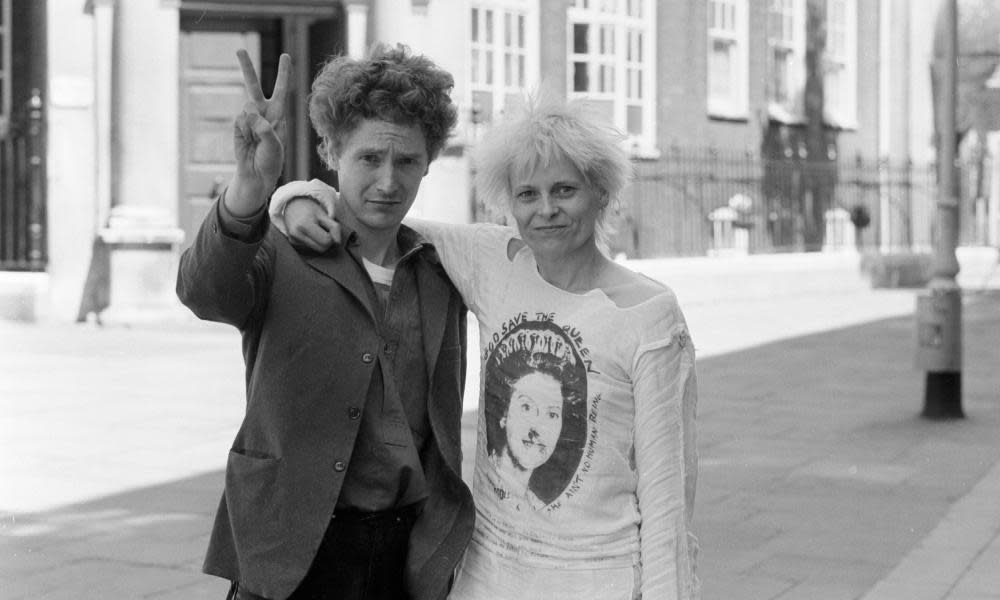The Life and Times of Malcolm McLaren by Paul Gorman review - punk's king of chaos

Writing about Malcolm McLaren in 1978, his friend from art school Fred Vermorel described him as having “the vision of an artist, the heart of an anarchist and the imagination of a spiv”. It is still the most trenchant summation of a figure who, 10 years after his death and four decades on from the great punk disruption that he helped precipitate, remains oddly elusive in terms of his cultural importance. Paul Gorman’s exhaustive biography goes some way to explaining why this is the case.
The Life and Times of Malcolm McLaren is a big book, nearly 900 pages long, and a detailed one, sometimes doggedly so. It traces a life that, by any standards, was eccentric and gleefully wayward. A self-styled cultural anarchist, who came of age in the political upheavals of the late 1960s, McLaren also modelled himself on old-school showbiz impresarios from the 1950s such as Larry Parnes, who controlled every aspect of the lives of the young singers on his books.
In McLaren’s world, contradictions were a given, moments of inspired creative iconoclasm often going hand in hand with tawdry opportunism, loyalty with extreme ruthlessness. During punk, this made him a figure of suspicion to many who saw him as a huckster rather than a visionary. In truth, he was a bit of both, and, as such, became a victim of his own double standards when it came to his credibility. With McLaren, even those closest to him never knew where they stood.
His later career as a film-maker, curator, and pop-cultural zeitgeist surfer, was a protracted coda to the main event.
Of the many slogans he created, Cash from Chaos was perhaps the most fitting, neatly distilling his opportunism and hinting at the confusion he and his punk cohorts engendered as they set out to topple the old order. The chaos, though, had a cost. Its most infamous casualty was the hapless and spectacularly self-destructive John Simon Ritchie, AKA Sid Vicious, whom McLaren encouraged in his boorish and nihilistic behaviour. Vicious died from a heroin overdose having been charged with the murder of his girlfriend, Nancy Spungen, in October 1978.
Nihilism had always been a trope of punk posturing, but the selling of Sid Vicious as the ultimate loser – a “punk” in the older noir meaning of the word – would prompt John Lydon (alias Rotten) to call McLaren “the most evil man on earth”. Gorman provides much evidence to the contrary, citing McLaren’s loyalty to Vicious throughout the grim drama of his final days.
The big problem with Gorman’s account of the rise of the McLaren, the Sex Pistols, and punk culture is that it is well-trodden territory. He does dig deeper and, in the process, uncovers some relatively overlooked characters, including the British artist David Harrison, an extravagantly stylish 19-year-old who was an early contender for lead vocalist in the group.
“They’d look at each other and say: ‘I ain’t wearing that. I’d look like a right poof’,” recalls Harrison of guitarist Steve Jones and drummer Paul Cook, whose wide-boy attitude epitomised the more lumpen strain of working-class punk authenticity.
Gorman also touches on the complex relationship between McLaren and Rotten, who played the Artful Dodger to McLaren’s Fagin for a brief time before their competing egos and controlling instincts took over. For all that, there is much here that will be familiar to anyone with even a passing interest in the punk era.

The first third of the book is the most compelling, tracing McLaren’s strange upbringing, his courtship of Vivienne Westwood and their creative partnership. Westwood was one of several strong female figures in McLaren’s life, beginning with his grandmother, Rose, a lifelong role model whose mantra was “To be bad is good, because to be good is simply boring”. Gorman notes that the young McLaren shared a bed with Rose as a child and “would do so intermittently into his late teens”.
McLaren’s own mother, Emily, was a distant figure, who, much to Rose’s disapproval, went off “gallivanting” when her marriage broke down. Decades later, McLaren recounted how he had once spotted her sitting in the same carriage as him on a train, but did not make contact. His emotional dislocation is a recurring theme, often expressed in a casual amorality that remains shocking to this day. With Westwood, he produced a range of T-shirts featuring a motif of the notorious “Cambridge Rapist” and, as manager of the post-punk pop group Bow Wow Wow, had plans to publish a sexually provocative teen magazine called Chicken aimed at their pre-pubescent fans.
Having made his name as a social archaeologist of British style culture – his previous book was a history of the Face magazine – Gorman is adept at chronicling McLaren and Westwood’s formative working partnership as they struggled to introduce their iconoclastic clothes to an unsuspecting world. The social history of their various Kings Road emporiums – Let It Rock, which morphed into Too Fast to Live, Too Young to Die, and later became Sex – would in itself have made an interesting book.
It is unsurprising that McLaren struggled to find his niche after punk. Though punctuated with moments of inspiration, his later career as, by turns, a film-maker, scriptwriter, curator, and pop-cultural zeitgeist surfer, was a protracted coda to the main event. In the end, Malcolm McLaren may have been his own worst enemy, the contradictions he embraced ultimately subverting his own credibility to a terminal degree.
Of one of his many ill-fated adventures, he said: “I have been called many things: a charlatan, a conman, or, most flatteringly, the culprit responsible for turning British popular culture into nothing more than a cheap marketing gimmick. This is my chance to prove that these accusations are true.” Look around you, his legacy endures, but it is the very antithesis of punk.
• The Life and Times of Malcolm McLaren by Paul Gorman is published by Little, Brown (£30)


